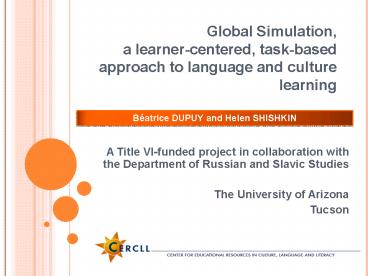Global Simulation, a learnercentered, taskbased approach to language and culture learning - PowerPoint PPT Presentation
1 / 19
Title:
Global Simulation, a learnercentered, taskbased approach to language and culture learning
Description:
A Title VI-funded project in collaboration with the Department of Russian and Slavic Studies ... RUSSIAN GLOBAL SIMULATION. Why this global simulation? More ... – PowerPoint PPT presentation
Number of Views:157
Avg rating:3.0/5.0
Title: Global Simulation, a learnercentered, taskbased approach to language and culture learning
1
Global Simulation, a learner-centered,
task-based approach to language and culture
learning
Béatrice DUPUY and Helen SHISHKIN
- A Title VI-funded project in collaboration with
the Department of Russian and Slavic Studies - The University of Arizona
- Tucson
2
WHAT IS GLOBAL SIMULATION?
- global simulation is simultaneously an
approach, a set of classroom techniques, and the
conceptual framework for a syllabus. (Levine,
2004, p.27) - Research support is strong
3
GLOBAL SIMULATION CALLS FOR
- The creation of a fictive yet culturally-grounded
world with a space, characters, events, etc. - Students to assume each a character and
collaborate to create and animate the setting in
which they live - Contextualizing the activities that take place to
bring life to the space students created - An end which often takes on the form of a novel,
a play, etc. in which characters and artifacts
already produced may be reintroduced
4
THE PURPOSE OF GLOBAL SIMULATION IS
- Re-center instruction on the learner
- Promote more active learning
- Develop free-expression and creativity
- Foster true communicative competence in
culturally meaningful and relevant contexts
5
KEY CHARACTERISTICS OF GLOBAL SIMULATION
- Long term
- Global, whats in a word?
- Entire range of authentic oral and written
exchanges possible in and around the chosen space
is explored. - Full gamut of curricular areas other than foreign
languages are tapped into when needed. - Language skills but also practical skills (e.g.,
posting on a blog, etc.) and cognitive skills
(goal setting, product archiving, leadership,
etc.) can be promoted, and affective behaviors
such as self-confidence and risk-taking can be
fostered.
6
KEY CHARACTERISTICS OF GLOBAL SIMULATION
- Phases and stages preceded and followed by
briefing and debriefing sessions - Teachers and learners as one with a focus on the
learner
7
GLOBAL SIMULATIONS AND THE 5CS
Communication
Cultures
Communities
Connections
Comparisons
8
RUSSIAN GLOBAL SIMULATION
- Why this global simulation?
- More general and adaptable
- Greater opportunities to make connections with
previous coursework done by students - The int. level, a time to focus on (Harlow
Muyskens, 1994) - Overall self-confidence in the language
- Increasing use of technology
- Reviewing grammar structures
- Improving teaching of writing
- Focus on cultural knowledge
9
TECHNOLOGY IN GS
- Web for written, audio, and video resources
- Software for online communication and role plays
(Skype) - GoogleSketch for virtual apartment
- YouTube for video
- LiveJournal for GS blogging
- Course website with multiple resources
(http//members.cox.net/helensh)
10
ON THE WEB
11
DEVELOPMENT AND IMPLEMENTATION
- Level adjustment
- Technological problems with GS for Russian
- Setting up the stage
- Involvement
12
SAMPLE STRUCTURE
- Getting ready
- Going over vocabulary
- Coming up with situations
- Role plays
- Usually in pairs
- Set up by instructor or by students
- Written part
- LiveJournal entries
- Debriefing
13
Sample Students Assignments
- Written
- ???????? ??? random entry
- ??? ????????? ??????? assigned topic
- ?????????? assigned topic but their choice
- Oral
- Answering machine message
- Video
- ??? ????????
14
Assessment
- PALS rubrics
- Holistic vs. analytic
- D2L with grades
- Projects on the website
- Group projects
- Final project
15
BENEFITS OF GLOBAL SIMULATION
- Extension of the range of experiences normally
made available to learners in the FL classroom
declassrooming the classroom (Sharrock
Watson, 1985) - Opportunities for learners to create their own
communication realities rather than waiting for
the teacher to provide them - Richer and more authentic language than in
typical teacher-driven classroom - Larger quantities of input in the TL
16
BENEFITS OF GLOBAL SIMULATION
- Provide students with an appealing and relevant
context, in which they make decisions, solve
problems, negotiate and reach agreement, etc. - Allow freer interaction which is itself more
engaging - Prompt students to practice a variety of
communication strategies - Synonyms, circumlocution, gestures, etc when
lacking vocabulary or structure for a particular
purpose - Turn-taking
17
BENEFITS OF GLOBAL SIMULATION
- Provide a relatively safe environment in which
learners can try new behaviors without any
serious effects on the outside world - Involve some form and degree of re-identification
which may encourage learners to elaborate new
behaviors and take risk
18
BENEFITS OF GLOBAL SIMULATION
- Have the ability to reflect the culture of the
target language and thus help students with the
cultural and social significance of the target
language - Promote learning through play simulation
encourage adolescents and adults to once again
play with symbols and enjoy themselves while
learning (Saunders Crookall, 1985)
19
DOWNLOAD PPT http//cercll.arizona.edu/resources
.php































